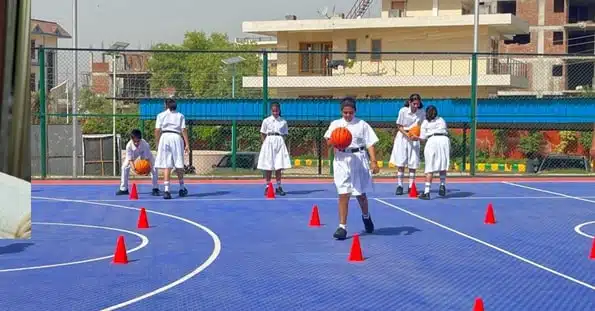The Importance of Physical Education in School
Children today are surrounded by digital distractions and packed schedules that leave little room for outdoor play. Therefore, the importance of physical education cannot be overlooked. Physical activity helps build strong minds, confident personalities, and healthy habits for life.
Schools play an important role in shaping well-rounded students. They help children excel in academics while balancing movement, teamwork, and self-discipline.
Through physical education, children learn valuable qualities such as strength, cooperation, and respect for health. Let’s explore why physical education is essential in schools.
What is Physical Education?
Physical education, often called PE, is an academic subject that focuses on improving physical fitness, coordination, and overall well-being through structured activities like sports, exercise, and movement-based learning.
It involves everything from running and stretching to games that encourage teamwork and skill development. PE helps children understand their bodies, develop strength and flexibility, and recognize the value of staying active.
When schools integrate it properly into the curriculum, it nurtures both body and mind, helping students stay alert, energetic, and ready to learn.
Objectives of Physical Education

The objectives of physical education go beyond exercise. PE enhances flexibility, stamina, coordination, and endurance through regular movement. These activities ensure that children develop healthy posture, better reflexes, and physical strength from a young age.
Participating in sports builds resilience and confidence, teaching students to control emotions and manage pressure. Beyond physical benefits, the purpose of physical education also includes cognitive growth. Physical activity sharpens memory, concentration, and decision-making.
Another key objective is to teach integrity and fairness. Through sports, children learn honesty, respect for rules, and responsibility toward teammates.
Team games and group exercises build strong social connections. Students learn to cooperate, communicate, and respect the opinions of others.
Benefits of Physical Education for Kids
Physical education benefits children in multiple ways — physically, mentally, socially, and academically. Below are the key benefits of physical education.
1. Physical Fitness and Health
Physical Education helps build strong bones and muscles, improves cardiovascular health, and boosts stamina. Regular movement also prevents obesity and lifestyle diseases like diabetes. Children who stay active from a young age are more likely to continue healthy habits as adults.
2. Mental and Emotional Well-being
Exercise releases endorphins, the hormones responsible for happiness and reduced stress. Activities like yoga or outdoor games calm the mind and lower anxiety levels.
Physical education supports emotional balance, improves sleep quality, and increases self-esteem. Students become more focused, confident, and positive about themselves.
3. Academic Improvement
Physical activity improves blood circulation to the brain, leading to better memory and concentration. Active students perform better academically because they can focus longer and handle pressure effectively.
4. Social and Behavioral Development
Through group activities, children learn the value of teamwork, cooperation, and respect. They understand the importance of following rules and develop patience while waiting for their turn. Participation in team sports also helps reduce aggression and promotes empathy.
5. Life Skills and Discipline
Physical Education encourages children to set goals, work hard, and stay committed, traits that are essential in every aspect of life. It builds leadership qualities and time management skills while teaching them how to handle both success and defeat gracefully.
6. Promotes Healthy Competition
Physical education teaches kids how to compete in a fair and respectful way. They learn to set goals, give their best effort, and accept both winning and losing with a positive attitude. Healthy competition helps children build confidence and resilience.
7. Reduces Stress and Increases Relaxation
Physical Education gives children a great way to release stress from studies or daily routines. Playing sports, running, or even simple exercises help relax the body and mind. This keeps kids happy, calm, and more focused during learning hours.
8. Encourages Cultural Awareness
Through PE, children are often introduced to different games and sports from around the world. Learning about these activities helps them understand and appreciate other cultures, building respect and global awareness from an early age.
9. Opens Career Opportunities
Physical education can inspire children to explore careers in sports, health, and fitness. It can lead to professions like coaching, sports therapy, physical education teaching, or fitness training. Physical Education helps children discover their talents and interests for the future.
These benefits show the need for physical education in every school’s daily routine. It’s a vital part of raising strong, confident, and capable individuals.
Role of Schools in Promoting Physical Education
Schools play an important role in shaping active, healthy lifestyles among students. The following steps show how schools can encourage participation and create an inclusive environment for physical fitness:
- Qualified instructors: They help students learn safe and effective techniques while inspiring them to enjoy fitness.
- Facilities: Schools should ensure access to playgrounds, equipment, and spaces suitable for different age groups.
- Inclusivity: Every student should feel welcome to participate, regardless of ability level. Fun and diverse activities help sustain interest.
- Community programs: Awareness programs, health drives, and marathons encourage students to stay fit beyond regular PE classes.
Challenges in Implementing Physical Education
Implementing strong physical education programs can be challenging for schools due to certain limitations:
- Limited Infrastructure: Some schools lack proper playgrounds or sports equipment. Schools can overcome this by using shared public spaces or community partnerships.
- Time Constraints: Academic schedules often leave little time for Physical Education. Schools can include short activity breaks or ensure at least 2 PE sessions per week.
- Untrained Teachers: Regular workshops and professional development sessions can help teachers conduct safe, effective physical activities.
- Low Awareness: Parents and educators sometimes overlook PE’s long-term value. Awareness campaigns can help highlight its role in mental and physical health.
Conclusion
Physical education serves as a foundation of lifelong health, confidence, and success. Encouraging students to stay actively involved in sports and fitness helps them grow into disciplined, motivated individuals.
Schools like DPS Gurgaon understand that academic excellence goes hand in hand with physical well-being. The school follows an approach that values both learning and movement. They prepare students to lead energetic, healthy, and happy lives and follow their dreams with strength and confidence.

